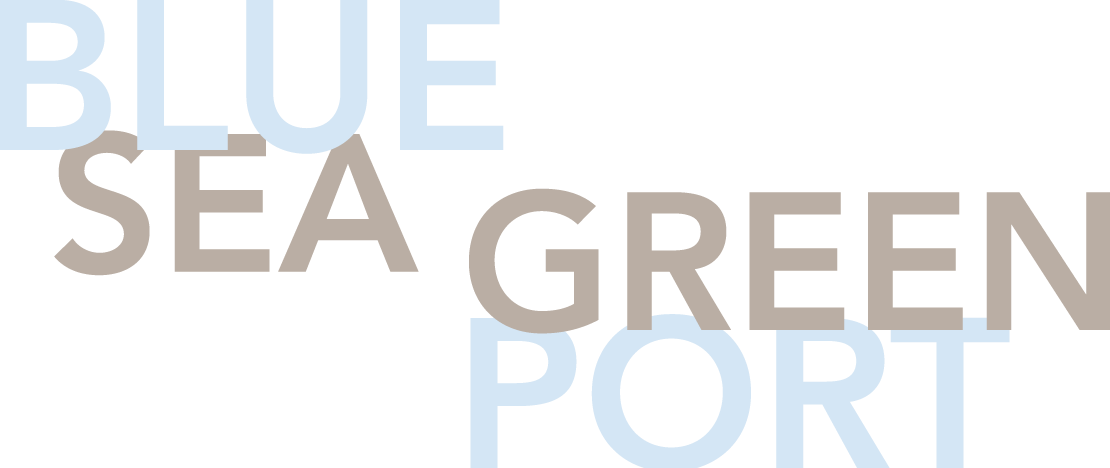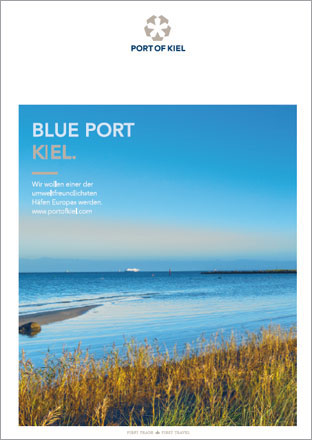BLUE PORT
Roadmap 2030.
Our way to more sustainability.
For us, BLUE PORT KIEL stands for the compatibility of sustainability and performance. As a port whose elements are water and air, we use the colour blue as a visual statement for an ecological future.
WE WANT TO BECOME ONE OF THE
MOST ENVIRONMENTALLY FRIENDLY
PORTS IN EUROPE.
Current status:
A clear difference.
If you want to be successful today, you have to be proactive when it comes to environmental protection and society. That‘s the only way we can be successful in the long term. We face the challenge of fulfilling and further developing the economic use of the port in the public interest of sustainability. This includes, in particular, climate protection, energy and resource efficiency and the avoidance of pollutants in the air and water as far as technically possible.
We want to be almost climate-neutral by 2030.
Current status: We are well ahead. In 2023, we emitted a total of 2,225 tonnes of CO2, made up of the company‘s own real estate and vehicle fleet. This represents a 12 per cent reduction in emissions compared to 2019. Ship emissions (with and without shore power) at all parts of the port, with the exception of Nordmole and Nordhafen, amounted to 10,602 tonnes of CO2in 2023. This represents a 34 per cent reduction in emissions compared to 2019.
The focus topics in which we are active run through the entire company: Ship supply, energy, vehicle fleet and transport, digitalization and strategic projects.
To find out more, scroll down.

In addition to supporting external projects and promotional measures, we also do our homework:

Ship drives
More and more ferries and cruise ships are now using shore power to meet their electricity needs at our terminals, switching off their engines and reducing their emissions to almost zero while at berth. A change is also taking place at sea with regard to ship propulsion systems.

Ship waste water
To keep our seas clean, it has been possible to discharge wastewater at the Ostseekai since 2007, and even longer at the ferry terminals. By operating one of the most modern reception facility for ship wastewater on the German coast, we have been meeting the requirements that came into force in 2021 since June 2017.

BLU.E-Mobility
We are gradually converting all industrial vehicles to electric or hydrogen drives. By participating in test operations, we are promoting the development of alternative drive systems for tractor units and forklift trucks. All other vehicles are to be refueled with CO2-neutral GTL wherever possible.

Air quality in the port of Kiel
The air quality in the port of Kiel is good. Even with multiple calls by cruise ships in the port, the limit values for air quality are not exceeded. We have repeatedly had this measured and compared using accredited measurement methods. The result, 2018 as in 2008: all values in the green zone.

Green Energy
Whether for shore power, real estate or for charging the e-vehicle fleet: since 2014, we at the PORT OF KIEL have covered our electricity requirements entirely from renewable energies and now also produce our own green electricity. The overall aim is to reduce our own electricity requirements and supplement them with self-generated green electricity.

Intermodal
Intermodal transport shifts transportation from road to rail and sea and leads to a significant reduction in pollutant emissions. We promote additional train connections in our port areas in order to redirect as much traffic as possible to more environmentally friendly modes of transport.
Future Port
The Baltic Sea
Due to its nature, the Baltic Sea is a very sensitive shipping and protection area. Here, ship emissions, the discharge of waste water, the disposal of waste, the fitting of oil tankers, the use of ship paints and the discharge of ballast water are regulated much more strictly than in almost all other shipping areas in the world. Not least due to its designation as an Emission Control Area (ECA), the Baltic Sea is one of the cleanest shipping areas in the world. Shipping companies have invested in new technologies to make ships even more efficient and permanently reduce emissions.
We believe that the global implementation of the limit values of 0.5 percent sulphur in ship emissions since 2020 is the right path towards a cleaner environment.
PORT OF KIEL
Our port is located in the middle of one of the few worldwide ECA special zones for shipping, which were defined by the International Maritime Organization (IMO) and in which special environmental guidelines apply to emissions as well as waste and process water disposal. Nevertheless, there is still room for improvement. We also want to make our contribution and become one of the showcase ports on the Baltic Sea. The port of Kiel will continue to grow. And this is ecologically beneficial, as shipping is the mode of transport with the lowest emissions of greenhouse gases, measured in terms of transport performance in tonne-kilometres.
Shipping
Over 90 percent of global trade, almost 95 percent of the European Union's foreign trade and almost 70 percent of German imports and exports are handled by sea. Maritime shipping is not only the most efficient means of transportation in the international exchange of goods, but also the most efficient in terms of transport-related energy consumption and the associated environmental impact.












